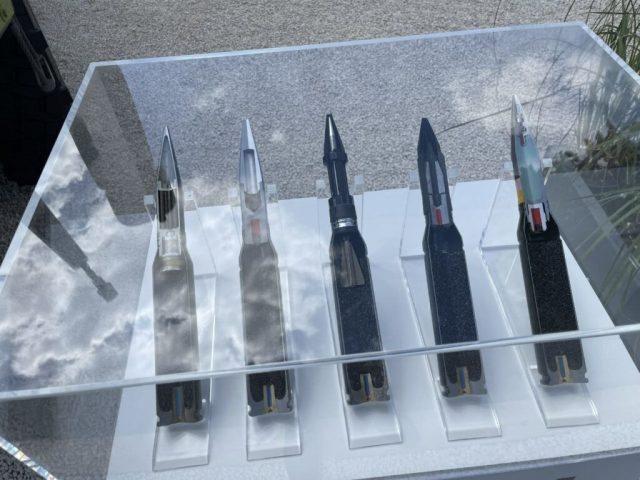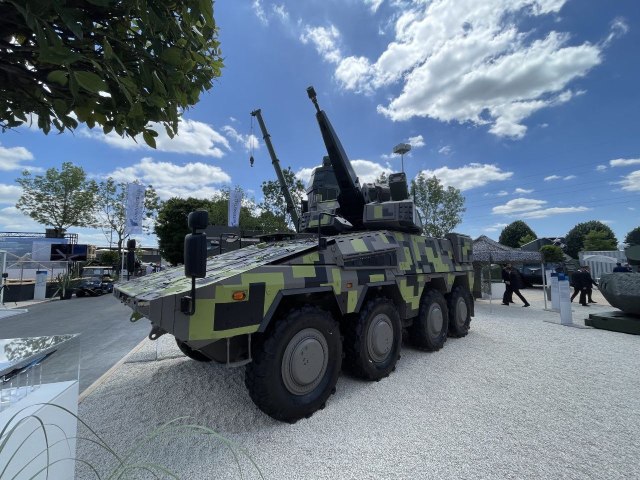However, according to its measurable parameters, the Skyranger 30 looks advanced except in the Western world. It seems that an annoying inaccuracy has crept into the manufacturer's assessment.
At the Eurosatory 2022 exhibition, held from June 13 to 17 in Paris, a new version of the Skyranger 30 anti-aircraft self-propelled gun was presented, combining a high-velocity cannon and anti-aircraft missiles. The manufacturer of the system, German Rheinmetall, emphasizes that such air defense systems "are gaining new importance, as NATO and the armies of partner countries are again focusing on the protection of <...> territories and airspace."
The importance of the car in the new conditions has really increased: during the Afghan-type wars (2001-2021), the forces of NATO and the allies of the alliance were unable to fight enemy aircraft.
Demonstration shooting of a 30-mm Skyranger 30 cannon on a drone / ©Rheinmetall
The Skyranger 30 machine shown at the exhibition is based on the chassis of the Boxer heavy armored personnel carrier (the mass of various modifications is in the range of 26-40 tons). It is equipped with the Sykranger 30 turret (which gave the name to the self-propelled gun as a whole). The turret has an automatic cannon with a caliber of 30 millimeters and a rate of fire of 20 rounds per second. The range of effective destruction of targets for it is indicated in three kilometers.
To increase the cover range of their troops, the Skyranger 30 is also equipped with anti-aircraft missiles. Unfortunately, the manufacturer did not provide details about the parameters of the latter. Earlier, the possibility of arming the system with anti-aircraft missiles and an infrared homing head was announced. Such systems do not provide their own radar radiation, which makes it extremely difficult for enemy pilots to notice their launch. The range of such missiles for Skyranger is announced at eight to nine kilometers, but they cannot be launched closer than two kilometers from a self-propelled gun — and an automatic cannon will insure the missiles in this zone.
Rheinmetall evaluates the parameters of the latter exceptionally highly: "with a firing rate of 1200 rounds per minute, a 30-millimeter cannon <...> is the best weapon in the world in this caliber." Probably, an annoying inaccuracy has crept into the company's assessment.

Various types of Skyranger 30 projectiles are capable of remote programmable detonation at the target, a standard feature of anti-aircraft self-propelled projectiles of recent decades / © Rheinmetall
Even the old Soviet anti-aircraft missile self-propelled gun "Tunguska" was armed with a pair of guns of the same caliber at once. But thanks to the liquid cooling of the barrels, she was (and is, because the machine has been involved in battles for decades) firing at a rate of 1950-2500 rounds per minute per barrel (a total of 4000-5000 rounds per minute for two barrels). This means that each of its guns fired one and a half to two times faster than the Skyranger 30 exhibition sample.
In general, however, the wheeled Skyranger 30 resembles not so much a "Shell" as the same "Tunguska" (although the latter is tracked). The range of 9M311 anti—aircraft missiles at Tunguska is eight kilometers, in the range announced for the new German self-propelled gun. However, the Soviet analogue was adopted in 1982, and the Skyranger 30 has not yet been officially adopted by any of the NATO countries.

Anti-aircraft self-propelled gun / ©Wikimedia Commons
It is not entirely clear why Rheinmetall did not want to create an analogue of the later "Shell" — if not its latest modification with a range of 40 kilometers, then at least a basic one with a range of hitting targets with missiles up to 20 kilometers and three to four times more powerful cannon fire.
Perhaps the German manufacturer was guided not so much by the parameters of the Russian machine, as by the realities of the NATO armies. There are practically no anti-aircraft missile systems of the Tunguska/Pantsir type there today. Against this background, the Skyranger 30 looks pretty good: at least it is there.

